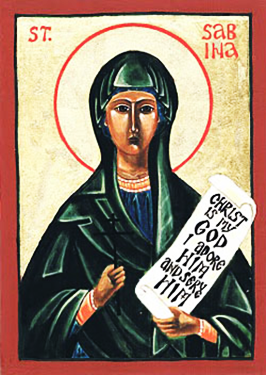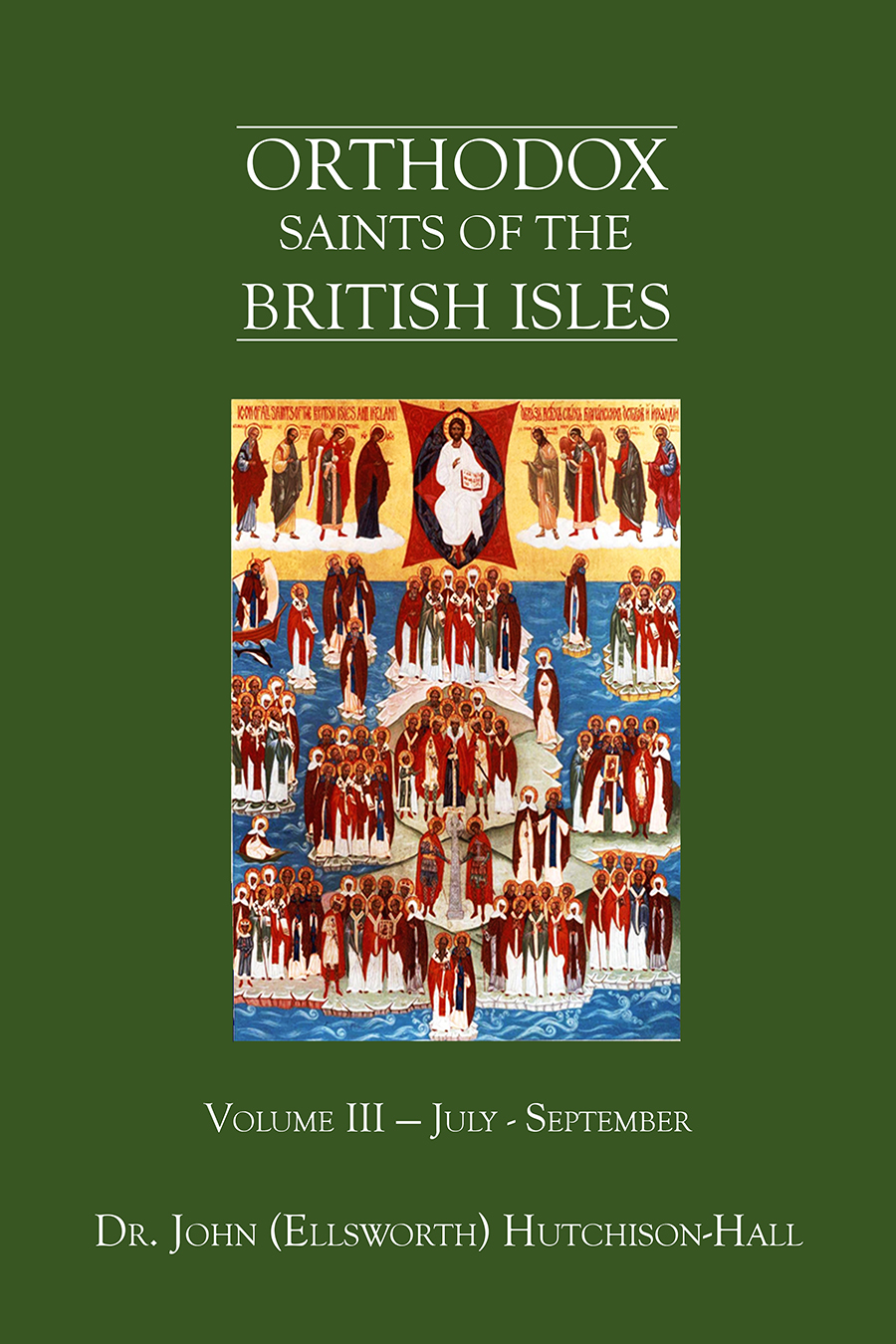
Orthodox Saints of the Pre-Schism
See of Rome
11th September (NS) — 29th August (OS) 2023
ADELPHUS of METZ, (Fifth Century), believed to have been the tenth Bishop of Metz (north-east France), St. Adelphus succeeded St. Rufus of Metz (7th November) and ruled the See for seventeen years. Unfortunately, nothing certain is known of him, as all information on his life was added to the various martyrologies at much later dates. Hence, the aforementioned is really based upon conjecture; however, the existence of his cultus going back to an early date is without question.
ALBERIC of BAGNO di ROMAGNA, a hermit in present-day north-eastern Italy. St. Alberic reposed circa 1050, and his relics are enshrined in the Benedictine San Anastasio Church in the Roman Catholic Diocese of San Marino-Montefeltro. Nothing further is known of him.
CANDIDA of ROME, (Date Unknown), one of a group martyred on the Ostian Way outside the gates of Rome. Her relics were enshrined in the ninth century at the Basilica of Saint Praxedes, (Basilica di Santa Prassede all’Esquillino), on the Via di Santa Prassede in Rome. She has been variously described as both a virgin martyr and simply a martyr, but nothing is actually known about her.
EDWOLD (EADWOLD) of CERNE (the HERMIT), St. Edwold was most likely the brother of St. Edmund the Martyr (20th November), King of the East Angles (r. c. 855–869). A wonderworker, he lived as a hermit at Cerne, in Dorset, England, in the latter half of the ninth century. Shortly after his repose St. Edwold was venerated as a saint. No further information on his life is known to us.
EUTHYMIUS of PERUGIA, a Roman who fled to Perugia with his wife and son, St. Crescentius of Rome (14th September), during the Diocletianic Persecution (303–313). St. Euthymius reposed in the early fourth century at Perugia.
MEDERICUS (MERRI), born in Autun, Burgundy (France) to a noble family, he received monastic tonsure at the Abbey of St. Martin (l'abbaye Saint-Martin d'Autun) in Autun at the age of thirteen, eventually serving as its abbot. The last few years of his life were spent as an anchorite. He is said to have reposed circa 700 whilst on a pilgrimage to the tomb of St. Germanus of Paris (28th May). St. Medericus is the patron saint of Paris’ Right Bank and the Église Saint-Merri located in Rue Saint Martin in the 4th Arrondissement of Paris commemorates his name.
SABINA of ROME, it seems she was a wealthy Roman widow who was converted by the pious example of her Christian servant St. Seraphia the Martyr (29th July). St. Sabina was most likely martyred in the persecution of Christians during the reign of Emperor Hadrian (r. 117–138). The historic Basilica di Santa Sabina all'Aventino on the Aventine Hill in Rome is dedicated to her.
SABINA of TROYES, commonly thought to be the sister of St. Sabinian of Troyes (29th January). According to tradition she was baptised in Rome by the future Pope St. Eusebius (26th September); but as her parents were still pagans, she decided circa 276 to join her brother in Troyes (north-central France). As St. Sabina approached Troyes, she heard of St. Sabinian's martyrdom and prayed that she might join him soon in heaven. It is said that St. Sabina reposed immediately upon completion of her prayer.
SÆBBI of ESSEX (SEBBE, SEBBA), St. Sæbbi was joint King of Essex with his brother Sigehere, from 664 to 683. Following Sigehere’s repose in 683, St. Sæbbi ruled as sole King until 694, when he abdicated the throne and entered the monastery of Westminster (the present-day Westminster Abbey), which he had founded. St. Sæbbi spent the next three years in prayer and repentance. He reposed in 697 and was buried in St. Paul’s Cathedral in London. His tomb survived the fire at St. Paul’s in 1087, and his relics were translated to a black marble sarcophagus in the mid-twelfth century Unfortunately, his relics did not survive the Great Fire of London in 1666. A plaque commemorating St. Sæbbi was erected in the Wren designed cathedral.
VELLEICUS (WILLEIC), (Eighth Century), an Anglo-Saxon abbot who joined St. Swithbert of Kaiserswerth (1st March) in his evangelisation of the Germans. St. Velleicus later served as Abbot of Kaiserswerth Abbey (Kloster Kaiserswerth), in present-day Düsseldorf Germany.
Get your copy of Orthodox Saints of the British Isles today.
Available at Amazon or your favourite e-bookstore.
ADELPHUS of REMIREMONT, a grandson of St. Romaricus of Remiremont (8th December), whom he succeeded as Abbot of Remiremont in eastern Gaul. St. Adelphus reposed circa 670.
ÆMILIAN (EMILIAN), according to the oldest of records of the Church of Vercelli in Piedmont (north-western Italy), St. Æmilian was consecrated Bishop of Vercelli after living as a hermit for forty years. He reposed in 520, having lived to over 100 years of age. No further information seems to be extant.
ALMIRUS (ALMER, ALMIRE), a hermit at Gréez-sur-Roc in present-day north-western France. St. Almirus reposed circa 560.
DEINIOL (DANIEL) of BANGOR, very little is known of St. Deiniol’s life. He is considered the founding Abbot of Bangor Abbey (Gwynedd, north-western Wales), and thought to have been consecrated Bishop of Bangor by St. Dubricius of Wales (14th November). St. Deiniol reposed circa 584 and was buried on the Isle of Bardsey off the Llyn Peninsula in Gwynedd, Wales. Following his repose, the cathedral at Bangor and several other churches in Wales were dedicated to his honour.
FELIX, REGULA, and EXUPERANTIUS of ZÜRICH, Martyrs of Zürich, St. Felix and his sister St. Regula along with their servant St. Exuperantius fled (circa 287) to Turicum (present-day Zürich, Switzerland) hoping to avoid the pursecutions going on during the reign of the Emperor Maximian (r. 286–305). Unfortunately, they were found and martyred.
LEUDINUS of TOUL (BODO), a member of Austrasian nobility and brother of St. Sadalberga (22nd September). St. Leudinus married, though he and his wife jointly decided to enter monastic life, with St. Leudinus receiving tonsure at the Abbey of St. Vincent (abbaye Saint-Vincent de Laon) in Laon, Picardy (northern France). St. Leudinus rather reluctantly accepted his selection to be the sixteenth Bishop of Toul (north-eastern France), and as bishop founded the Abbey of Bonmoutier (abbaye de Bonmoutier) in Val-et-Châtillon (north-eastern France), the Abbey of St. Peter (abbaye Saint-Pierre d’Étival), in Étival-Clairefontaine (north-eastern France), and several others. St. Leudinus reposed circa 678.
PATIENS, Archbishop of Lyons (east-central France) from circa 456 until his repose circa 491, who according to his contemporary St. Sidonius Apollinaris (21st August), despite the austerity of his life, he made himself “all things to all men”. St. Patiens played an active role in fighting the heresies of his day, but is chiefly remembered for devoting all of his income to the poor. St. Patiens reposed circa 491.
PROTUS and HYACINTH of ROME, Martyrs of Rome, according to tradition SS. Protus and Hyacinth were brothers who served in the household of St. Eugenia of Rome (25th December), and had been baptized along with her. SS. Protus and Hyacinth were martyred circa 257 in Rome during the persecution of Christians under the Emperor Valerian (r. 253–260).
VINCENT of LEÓN, an Abbot of St. Claudius in León (north-western Spain) who was martyred by the Arian Visigoths. There is some disagreement about the date of his martyrdom, with some sources giving circa 554, and others circa 630 as the date.
Prior to the Schism the Patriarchate of Rome was Orthodox, and fully in communion with the Orthodox Church. As Saint John of Shanghai and San Francisco +1966 said “The West was Orthodox for a thousand years, and her venerable Liturgy is far older than any of her heresies”.
Details of British Saints excerpted from Orthodox Saints of the British Isles.
Details of continental saints from these sources.
In many cases there are several spelling versions of the names of saints from the British Isles. I use the Oxford Dictionary of National Biography version as the primary version with the more prevalent version in parenthesis e.g. Ceadda (Chad) of Lichfield.


